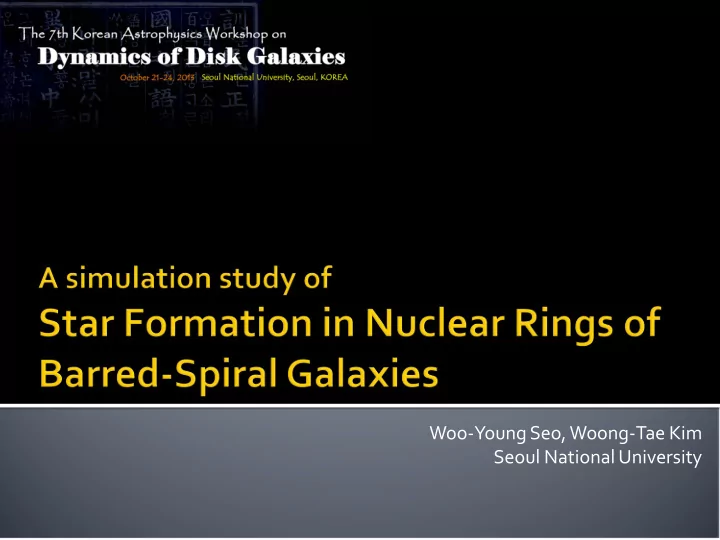

Woo-Young Seo, Woong-Tae Kim Seoul National University
Nuclear rings in barred-spiral galaxies are sites of intense star formation. Observations indicate that the star formation rate in nuclear rings differs from galaxy to galaxy and widely distributed in the range of 0.1-10 M ⊙ yr −1 .
Observational estimates Continuous SF ▪ van der Laan et al. (2013) find that the circumnuclear ring in NGC 6951 has been forming stars for ~1Gyr. ▪ SFR is low (~0.1 M ⊙ yr −1 ). Multiple-burst SF ▪ Using stellar population synthesis models Allard et al. (2006) estimate SFH of M100(NGC 4321) is multiple-burst type. ▪ Sarzi et al. (2007) show two more galaxies (NGC4314 and NGC 7217) also have multiple-burst SF using same method.
Observations Some galaxies show an age gradient along the azimuthal direction. Some galaxies do not show a gradient. (Mazzuca et al. 2008, Ryder et al. 2010, Brandel et al. 2012) Two models of star formation(Böker et al. 2008) Popcorn model : SF sites are randomly distributed in the whole ring region. Pearls-on-a-string model : SF occurs in over dense regions located at the contact points.
What makes multiple-burst star formation? Why the location of star formation differs from galaxy to galaxy?
Consider a 2D gaseous disk that is isothermal ( c s =10 km/s) and self- gravitating. Use an exponential gaseous density profile (Bigiel & Blitz, 2012) . Bar potential is modeled by Ferrers prolate. (Athanassoula, 1992) Bar fraction f = 30%, Major axis = 5kpc, Axis ratio a/b = 2.5 Pattern speed of a bar = 33 km/s/kpc Include SF & feedback Prescription. Take both models without spirals and with spirals.
SFR is well correlated with the mass inflow rate to the ring. The SFR shows a strong primary burst that is caused by the rapid gas infall to the ring due to the bar growth. SFR decrease rapidly after strong burst, since gas outside the bar region do not move inward by the bar potential. Only the gas inside bar region responds strongly to the bar potential, while the outer region is not much affected. Bar-only model cannot explain multiple- burst SF.
Candidate mechanisms for gas feeding : Angular momentum dissipation by spiral arms (Roberts & Shu 1972; Lubow et al. 1986; Hopkins & Quataert 2011) ▪ inside the co-rotation radius, gases move inward after passing spiral shock. Galactic fountains (Fraternali & Binney 2006, 2008). Cosmic accretion of primordial gas (e.g., Dekel et al. 2009) ▪ HVCs, ~ 0.7 M ⊙ yr −1 for M31/Milky-Way-type galaxies (Richter 2012) Add spiral arm potential F = 10% Pattern speed of arms = 10, 20, 33km/s/kpc (Co-rotation Radius : 20, 10, 6kpc)
Ω sp of spiral model is 10km/s/kpc In model without arms, the total mass inside 6kpc does not increase after 200 Myr. No active star formation in the ring In model with spirals, the total mass increase continuously. Exhibits episodic bursts of star formation at late time. The total mass of the gas transformed into stars also increases continuously.
Spiral shock is stronger when Ω sp is smaller, resulting in a larger inflow rate. A model with Ω sp = 20km/s/kpc also shows multiple star burst activities. Increase mass and SFR in a model with Ω sp = 33km/s/kpc is almost the same with that in model without spiral arms, since the co-rotation radius is 6kpc. Pattern speed of M100 : Ω sp =20 km/s/kpc, Ω bar =30 km/s/kpc (Hernandez et al. 2005 : TW method)
When the SFR is larger than 1 M ⊙ yr −1 : Star formation is widely distributed throughout the whole length of the ring. When the SFR is smaller than 1 M ⊙ yr −1 : Ages of young star clusters exhibit an azimuthal gradient along the ring, since star formation takes place mostly near the contact points. If mass inflow rate to the ring is small, most of the inflowing gas can be converted to stars at contact points. If mass inflow rate is large, all inflowing gas cannot be transformed at contact points.
The maximum SFR expected from two contact points is simply Roughly 1 M ⊙ yr −1 in our models. NGC 6951 (van der Laan et al. 2013) SFR ~ 0.1 M ⊙ yr −1 SF type : pearls on a string model
Bar-only model can not explain multiple- burst SF. Spiral arms transport gas from outside region to the bar region, and that makes multiple- burst SF at nuclear ring. An azimuthal age gradient of star clusters is expected when SFR is low (less than 1 M ⊙ yr −1 in our models).
Recommend
More recommend